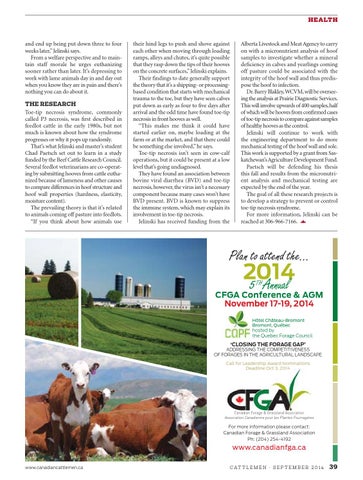health
and end up being put down three to four weeks later,” Jelinski says. From a welfare perspective and to maintain staff morale he urges euthanizing sooner rather than later. It’s depressing to work with lame animals day in and day out when you know they are in pain and there’s nothing you can do about it. The research
Toe-tip necrosis syndrome, commonly called P3 necrosis, was first described in feedlot cattle in the early 1980s, but not much is known about how the syndrome progresses or why it pops up randomly. That’s what Jelinski and master’s student Chad Paetsch set out to learn in a study funded by the Beef Cattle Research Council. Several feedlot veterinarians are co-operating by submitting hooves from cattle euthanized because of lameness and other causes to compare differences in hoof structure and hoof wall properties (hardness, elasticity, moisture content). The prevailing theory is that it’s related to animals coming off pasture into feedlots. “If you think about how animals use
their hind legs to push and shove against each other when moving through loading ramps, alleys and chutes, it’s quite possible that they rasp down the tips of their hooves on the concrete surfaces,” Jelinski explains. Their findings to date generally support the theory that it’s a shipping- or processingbased condition that starts with mechanical trauma to the toe, but they have seen calves put down as early as four to five days after arrival and the odd time have found toe-tip necrosis in front hooves as well. “This makes me think it could have started earlier on, maybe loading at the farm or at the market, and that there could be something else involved,” he says. Toe-tip necrosis isn’t seen in cow-calf operations, but it could be present at a low level that’s going undiagnosed. They have found an association between bovine viral diarrhea (BVD) and toe-tip necrosis, however, the virus isn’t a necessary component because many cases won’t have BVD present. BVD is known to suppress the immune system, which may explain its involvement in toe-tip necrosis. Jelinski has received funding from the
Alberta Livestock and Meat Agency to carry on with a micronutrient analysis of hoof samples to investigate whether a mineral deficiency in calves and yearlings coming off pasture could be associated with the integrity of the hoof wall and thus predispose the hoof to infection. Dr. Barry Blakley, WCVM, will be overseeing the analysis at Prairie Diagnostic Services. This will involve upwards of 400 samples, half of which will be hooves from confirmed cases of toe-tip necrosis to compare against samples of healthy hooves as the control. Jelinski will continue to work with the engineering department to do more mechanical testing of the hoof wall and sole. This work is supported by a grant from Saskatchewan’s Agriculture Development Fund. Paetsch will be defending his thesis this fall and results from the micronutrient analysis and mechanical testing are expected by the end of the year. The goal of all these research projects is to develop a strategy to prevent or control toe-tip necrosis syndrome. For more information, Jelinski can be reached at 306-966-7166. c
Plan to attend the...
2014 5 Annual TH
CFGA Conference & AGM November 17-19, 2014 Hôtel Château-Bromont Bromont, Québec
hosted by the Quebec Forage Council
‘CLOSING THE FORAGE GAP’
ADDRESSING THE COMPETITIVENESS OF FORAGES IN THE AGRICULTURAL LANDSCAPE Call for Leadership Award Nominations Deadline Oct 3, 2014
Canadian Forage & Grassland Association Association Canadienne pour les Plantes Fourragères
For more information please contact: Canadian Forage & Grassland Association Ph: (204) 254-4192
www.canadianfga.ca www.canadiancattlemen.ca
C at t l e m e n · S e p t e m b e r 2 0 1 4
39
